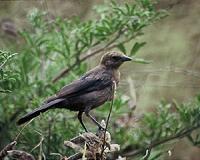 |
Durham NC (SPX) Mar 09, 2011 For the vast majority of plants and animals, the 'bigger is better' view of evolution may not be far off the mark, says a new broad-scale study of natural selection. Organisms with bigger bodies or faster growth rates tend to live longer, mate more and produce more offspring, whether they are deer or damselflies, the authors report. Researchers working at the National Evolutionary Synthesis Center compiled and reviewed nearly 150 published estimates of natural selection, representing more than 100 species of birds, lizards, snakes, insects and plants. The results confirm that for most plants and animals, larger body size and earlier seasonal timing - such as earlier breeding, blooming or hatching - confer significant survival advantages. "It's a very widespread pattern," said co-author Joel Kingsolver of the University of North Carolina at Chapel Hill. What's puzzling, the authors say, is not why the 'bigger is better' model of evolution is so common, but why the 'Goldilocks' model is so rare: If organisms are supposedly well-adapted to their particular circumstances, then why is it so seldom the case that the individuals that survive and reproduce the best are the ones that are not too small, nor too big, but just right? A classic example is human birth weight. Newborns of intermediate size are more likely to survive than newborns that are extremely large or extremely small. In lieu of driving organisms to be bigger and faster over time, the 'Goldilocks' model - also known as stabilizing selection - favors moderation, the authors explained. But for the vast majority of organismal traits, this pattern is the exception, not the rule. "Rarely is it the case that the individuals that survive and reproduce the best are the ones in the middle," Kingsolver said. The result is puzzling because the conventional wisdom is that most creatures are well adapted to the environments in which they live. "When we look at nature, we see all these amazing ways species are well-adapted to their lifestyles and habitats," Kingsolver said. "Yet the organisms that are bigger, faster, still do the best in terms of survival and reproduction. Why aren't they already just the right size or speed, or pretty close to it?" he asked. The authors explored three possible explanations. One possibility, they explained, is that evolving to be bigger, faster, or flashier comes at a cost. "A trait that's good for reproduction or fertility may be bad for survival - there may be a tradeoff," Kingsolver said. "In guppies, for example, brightly colored males have greater mating success, but they're also more likely to be eaten by predators," said co-author Sarah Diamond, currently a postdoctoral researcher at North Carolina State University. Another possibility is that environments simply change from one season to the next, such that the traits that confer the greatest advantage change over time. "In Darwin's finches, for example, there are years where large-beaked birds have an advantage because large seeds are more abundant, and years where smaller-beaked birds do better because small seeds are more abundant," Diamond said. A third possibility is that natural selection drives one trait in one direction, while simultaneously driving another, genetically correlated trait in the opposite direction. "For example it may be good for flying insects to evolve larger wings and smaller bodies for more efficient flight," Kingsolver said, "but if insects with larger wings also have larger bodies, they can't evolve both." The third explanation frequently limits the evolution of body size, the authors found, but not traits related to timing, or body shape, or coloration. "Size is the one case where correlated selection is important," Kingsolver said.
Share This Article With Planet Earth
Related Links National Evolutionary Synthesis Center (NESCent) Darwin Today At TerraDaily.com
 Fossil Bird Study Describes Ripple Effect Of Extinction In Animal Kingdom
Fossil Bird Study Describes Ripple Effect Of Extinction In Animal KingdomGainesville FL (SPX) Mar 09, 2011 A University of Florida study demonstrates extinction's ripple effect through the animal kingdom, including how the demise of large mammals 20,000 years ago led to the disappearance of one species of cowbird. The study shows the trickle-down effect the loss of large mammals has on other species, and researchers say it is a lesson from the past that should be remembered when making conserva ... read more |
|
| The content herein, unless otherwise known to be public domain, are Copyright 1995-2010 - SpaceDaily. AFP and UPI Wire Stories are copyright Agence France-Presse and United Press International. ESA Portal Reports are copyright European Space Agency. All NASA sourced material is public domain. Additional copyrights may apply in whole or part to other bona fide parties. Advertising does not imply endorsement,agreement or approval of any opinions, statements or information provided by SpaceDaily on any Web page published or hosted by SpaceDaily. Privacy Statement |